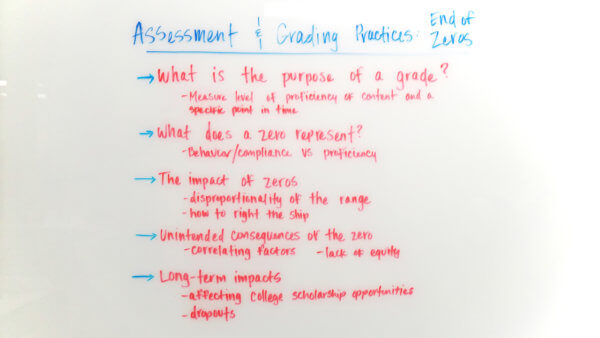Assessment & Grading Practices: The End of Zeros
https://youtu.be/TH5tX7YyqVI
Presented by Natalie Howell – Transcription Below
Introduction
Hi, welcome to Illuminate’s Whiteboard Series. My name is Natalie Howell, and I’m an implementation manager at Illuminate Education. Today’s conversation is about assessment and grading, the end of zeros.
What’s The Purpose of a Grade?
So to start this off, we have to understand, what is the purpose of a grade? In the average classroom, a grade is supposed to be a measure of student learning, how much the student has mastered as far as content goes. The grades in elementary school have conduct, so you know, there is a separate conduct grade, and so that is where behavior tends to be registered. And then the academic grade is going to be based on class performance.
A Zero is More Than a Grade
Now, a zero, what does a zero represent? To think about that, a zero is really representing behavior or compliance. It is not representing a student’s academic mastery of content. It is simply stating that a student has not turned in an assignment or not completed a project, or not done their homework. And so compliance is not a grade that should be measured within academic component. A student is not going to get a zero if they do any of the work. So it is simply just a reflection of behavior.
The Impact of a Zero
The impact of zeros, if you think about the standard grading scale, only about a third of that zero to a hundred is considered passing. So if you go below a 60%, everything from 60 to 0 is considered failure, whereas a very small component of that is meant to be any kind of success. And for a student to fix this, if a student gets a zero, oftentimes, it takes nine perfect assignments, after the zero, for the student to just right that ship. It is very difficult for a student to come out of that. And when a student feels like they can’t be successful, then they simply just start tuning out or shutting down.
Unintended consequences of the zero also have to do with correlating factors. Oftentimes, students who come from challenging situations, whether it be two working parents, whether it be a single parent who’s often not at home, whether it be any sort of difficulty like that, those are the students who have other issues, other problems at home, and then they come to school without those assignments. But in reality, those are the students who need that education more than anybody else. So we need to really focus on what is the intended purpose of that grade in helping those students to be more successful in terms of figuring out what they need to do in order to be better.
Long Term Impacts
So long-term impacts, grades are meant to be, again, a measure of academic mastery of content. If you think about high school, those transcripts that students get are meant to aid them in getting into college and oftentimes help them get college scholarships. A student who has mastered everything in a class deserves to get an A in that class. They should not get a B simply because they didn’t do assignments or homework that was meant to be practice, and then in turn, they didn’t need the practice. So that difference in grade could affect whether a student gets a complete scholarship to college or does not.
In Conclusion
And then of course, it also affects people or students in terms of dropouts. Those kids who continue to get zeros and don’t get any assistance from teachers in terms of really thinking about why they’re not completing these assignments, those students are going to continue to fail, and it just becomes a snowball effect. So those students, in turn, once they fail and fail and fail, are much more likely to drop out.
Whiteboard Image –

Audio Only –
*****
Illuminate Education is a provider of educational technology and services offering innovative data, assessment and student information solutions. Serving K-12 schools, our cloud-based software and services currently assist more than 1,600 school districts in promoting student achievement and success.
Ready to discover your one-stop shop for your district’s educational needs? Let’s talk.

